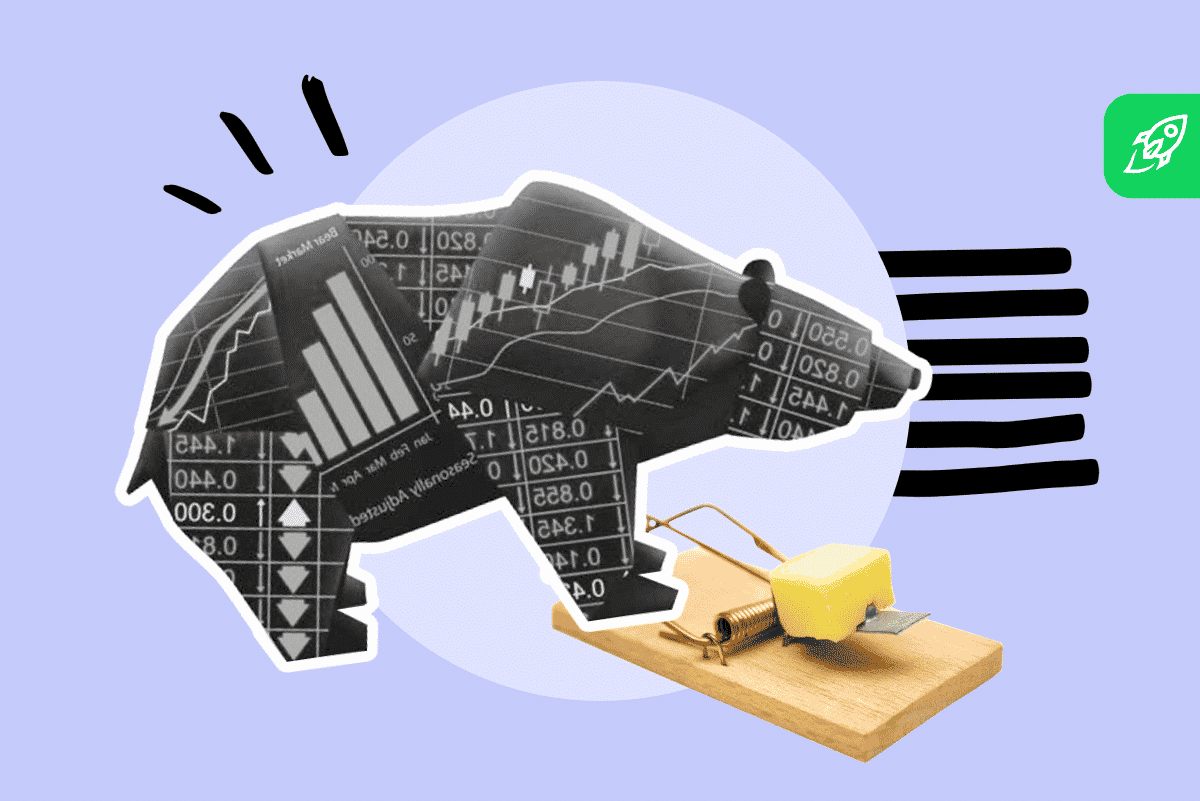The cryptocurrency market is an exciting place to trade, but it can also be a dangerous one. One of the biggest traps that traders fall into is known as a bear trap. This happens when there’s an explosive move upwards in the market, which then reverses and causes big losses for those who have shorted (gone “short”) the asset in question.
In this article we will cover what exactly a bear trap is, how it happens on the charts, indicators that show you when there might be one coming up, and how to avoid them!
What Exactly Is a Bear Trap?
Bear traps are sudden price reverses in a bear market. They’re not always obvious and can be hard to spot, but they can occur in any market. A bear trap occurs when the price of an asset, let’s say, the Hiseals coin, CSIX price suddenly moves sharply lower, only to reverse course and continue rising again–often with little warning.
Bear traps can be caused by many different factors: regulatory issues or macroeconomic news, for example. They may also result from manipulation by traders who want to profit off of other investors’ ignorance about what’s happening behind the scenes.
How Does Bear Trap Happen?
A bear trap is a price pattern where the price of an asset drops significantly, then recovers, only to drop again. The pattern usually happens when there’s strong upward momentum in a bull market and traders become overly bullish on their positions.
When this happens, they may sell their holdings at profits which causes demand to decrease while supply increases. This leads to downward pressure on prices as more sellers than buyers enter into the market and pushes them down even further until buying interest picks up again.
This kind of event has happened several times already in 2018 and it’s when we as traders can make great profits from buying low and selling high again in a short period of time. The key is identifying these situations early on, before they occur. Bear Trap can also occur on trading pairs such as BTC USDT and many others.
Indicators to Identify a Bear Trap Pattern
The first thing to do is look for signs of a bear trap pattern. Here are some indicators that can help you identify a bear trap:
-
RSI (Relative Strength Index)
-
Fibonacci Retracements
-
Volume Indicators
-
MACD (Moving Average Convergence/Divergence)
-
Stochastic Oscillator, Parabolic SAR and Trendline
Volume Indicators
Volume indicators are used to identify trends and reversals. A trend is the tendency of a market to move in one direction over time, while a reversal is when that market changes direction.
A volume indicator is simply an indicator that uses volume data (the number of shares traded) to create signals. There are many types of volume indicators, but they all have one thing in common: they use some measure of how much money is being invested in order to either confirm or refute your trading hypothesis.
For example, if you’re looking at an uptrending market (a trend), then you’d want your signals on this type of charting tool to show increasing volumes over time–and vice versa if you’re looking for lower prices by identifying areas where there has been less buying pressure than usual over the past few hours or days (a reversal).
Volume indicators can help determine support levels as well because these areas tend not only be where buyers have stepped back from buying recently but also where sellers may have gotten out after making profits elsewhere on higher priced assets before moving down into lower priced ones again later on down near their target exit point once again.
Fibonacci Retracements
Fibonacci retracements are a popular tool for traders to use when looking for support and resistance levels. They’re based on the Fibonacci sequence, which is a series of numbers that starts with 0 and 1, then continues with each number being the sum of the previous two. For example:
0 + 1 = 1
1 + 2 = 3
2 + 3 = 5
3 + 5 = 8
5 + 8 = 13 (and so on)
Fibonacci retracement levels are technical indicators used to determine where a stock will most likely stop going down after a decline. After a stock declines, it will begin to rebound. Some traders use different Fibonacci ratios to predict where the stock will reverse and stop going back up, in an attempt to buy the stock before it continues going up.
RSI Indicator
RSI (Relative Strength Index) is a momentum indicator that measures the magnitude of recent price movement. It’s calculated by comparing upward and downward closes over a certain period of time.
RSI is a lagging indicator, meaning it doesn’t predict future prices but rather shows the strength of past price movements. The RSI can be used to identify overbought or oversold conditions in an asset’s price chart and therefore help determine appropriate trading strategies such as when to buy or sell with greater confidence.
Risk of the Trap
You can make money if you’re right and lose money if you’re wrong. But it’s important to remember that the risk of the trap is real and always present. If a bear market hits your portfolio, it’s possible that your losses could exceed your initial investment–and even wipe out all of your gains from previous bull markets!
To avoid this problem, always keep an eye on how much money is at stake when entering any trade or investment position. If something goes wrong with one of these positions, cut your losses quickly before they become too large to handle easily; then move on with confidence knowing that there’s nothing left to lose (or gain).
How to Avoid a Bear Trap
-
Don’t risk more than you’re willing to lose.
-
Be methodical about cutting losses when you’re wrong.
-
Avoid illiquid markets, which are ones where there aren’t many buyers and sellers, making it hard to get out of a trade at a reasonable price if it goes against you.
-
Set a stop-loss order (a limit order that automatically sells your cryptocurrency if its price falls below a certain level), so that if something goes wrong with your trade, at least part of the loss can be mitigated by selling at least some of what’s been bought before things get worse–and don’t forget: always check with an experienced trader before using stop losses.
Avoid shorting
The simplest way to avoid the most painful bear trap is to avoid shorting, which can cause large losses when the market moves higher.
Instead, you should set a stop loss order at a price that’s lower than your entry price–preferably around 20-30% below your entry point–and then let your trade run its course. If you’re wrong about crypto’s direction, your stop loss will ensure that you don’t lose too much in case of an unexpected downturn (or vice versa).
Set a stop loss and also understand your risk.
If you trade a short position, set a stop loss. A stop loss is an order that tells your broker to sell your asset when it falls below a certain price. This protects your investment and prevents losses from getting too large.
The price at which you set the stop-loss order depends on two things: how much money/time/effort it would take for you to get back into the market if needed (the “cost” of re-entering), and how confident you are in being able to exit with profits?
If there’s not much cost involved in getting back into the market, then setting an earlier exit point might make sense; conversely, if re-entry would be expensive or time consuming (or both), then perhaps waiting until later would be better so as not to lose all those gains before they’re realized.
Avoiding illiquid markets is one way to avoid bear traps.
One way to avoid bear traps is by avoiding illiquid markets. The spot market is the most liquid market in crypto, but it can still be a bear trap if you’re not careful. If you buy or sell a large amount of coins on an exchange, your order may get stuck in limbo until someone else comes along and buys or sells at the same price point.
The futures market is also very illiquid–in fact, it’s even less liquid than spot trading because these contracts don’t exist yet. So when you enter into one, you’re betting on something that hasn’t even happened yet. This makes this type of investment extremely risky because there’s no guarantee that anyone will ever buy or sell those contracts; if no one does (or if too many people do), then your position could become worthless overnight.
Don’t risk more than you’re willing to lose
-
Don’t risk more than you’re willing to lose, and be methodical about cutting losses when you’re wrong.
-
Don’t try to time the market.
-
Don’t trade on emotion. This is especially true when things are going well; if it feels like a bubble and you start getting excited about the possibility of making millions overnight, it’s probably best for your health (and wallet) if you step away from trading for a while until those feelings pass. You’ll thank yourself later.
If this sounds familiar: don’t get caught in a bear trap! In fact, the only way out of one is by selling at some point. Which means that even if your thesis turns out not to be correct (which will happen), at least there’s still some hope left in terms of being able to recover some value before exiting completely.
Conclusion
We hope this article has helped you understand the bear trap and how to avoid it. Bear traps are one of the most common mistakes made by traders, but they don’t have to be – if you follow these simple tips, then you can avoid them in your own trading.








